Generally these minerals are only present when a thick sequence of pelitic or mud-rich rocks have been metamorphosed. In some terranes, the metamorphic gradient appears to skip a particular mineral zone when the chemistry is not quite right in a particular lithology. This type of metamorphism generally occurs during regional metamorphism due to a mountain building event, during which the rocks get progressively hotter and deeper as one approaches the center of the mountain belt.
It is ironic that although I am living in Scotland and having seen the “Barrow zones” with my own eyes that I would use examples of Barrovian metamorphism from central Spain. Unfortunately, many of the classic localities in Scotland to see these index minerals don’t provide the nicest examples. Instead, I will use Spain.
The Iberian Massif has undergone two main tectonic events during the Phanerozoic Eon; the Carboniferous Variscan and Tertiary Alpine orogenies. The first was associated with significant crustal thickening, deformation, regional Barrovian metamorphism culminating in melting and emplacement of peraluminous granite. The Alpine orogeny subsequently further deformed and folded the metamorphic Variscan “basement” and the post-Carboniferous strata.
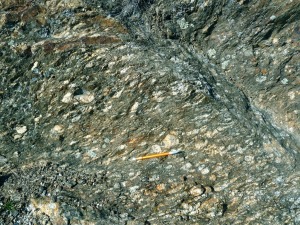 |
| Augen gneiss of the Variscan orogenic basement |
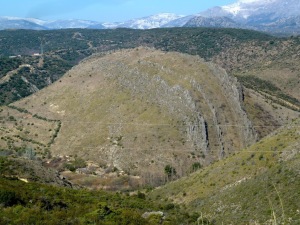 |
| Cretaceous Limestone near Torrelaguna deformed during the Alpine Orogeny with the La Cabrerra Granite in the background |
First up is the chlorite zone. The chlorite in these rocks is only apparent as the greenish hue of this phyllite. Generally, chlorite will disappear once you reach the biotite zone. The best way to see these chlorites is in thin section.
 |
| Chlorite bearing phyllite |
Next is biotite. Biotite forms as lathes or sheets draped along foliation planes. It is brown to black in color and is ubiquitous from the biotite zone even until partial melting starts to take place. Biotite might just be the most prevalent metamorphic mineral on the planet. Biotite can also be useful as a geothermometer. Darrell Henry at LSU noticed that in the presence of certain minerals (graphite, quartz, Ti-phase, and an aluminous phase) the titanium content of biotite increases systematically with temperature. He then developed a simple equation to convert Ti content to degrees.
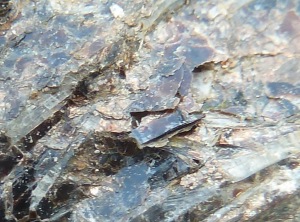 |
| Biotite |
Garnets. To a metamorphic geologist, garnets are the crème de la crème of minerals. When garnet begins to form in metamorphic rocks you know things are really starting to heat up. Garnet tends to grow above temperatures of 550 ºC and can continue to grow well above 1000 ºC. Garnets are especially important to metamorphic petrologists as a geothermometer and geobarometer. When the chemistries of biotite and garnet are paired a relatively simple calculation can give you the equilibrium temperature and plagioclase, biotite, garnet will give you pressure of metamorphism. Of course this is a terribly simplistic view of garnet geothermobarometry, but you get the idea.
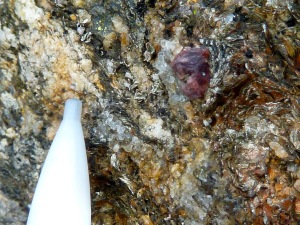 |
| Red garnet and biotite/muscovite |
Staurolite is a mineral most famous for its interesting twinning often in the shape of a cross (Greek: stauros for cross and lithos for stone). Although it is fairly rare to find a perfect cross (seen here) they are often found with imperfect twinning. Staurolite is almost always found in association with other metamorphic minerals, especially garnet.
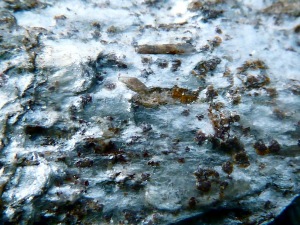 |
| Twinned staurolite and garnet in a matrix of white mica |
 |
| Garnet (center left) and staurolite (center right) |
Kyanite is a member of the classic aluminosilicate family (kyanite, sillimanite, andalusite). It is a spectacularly blue bladed mineral indicative of high pressures and relatively low temperatures. Its name comes from the Greek kyanos for its blue color. Kyanite is often used as a semiprecious stone and is mined extensively for ceramics in Virginia (here).
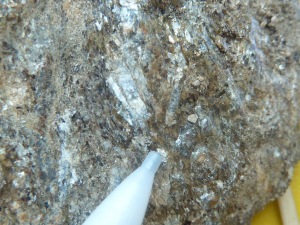 |
| Kyanite |
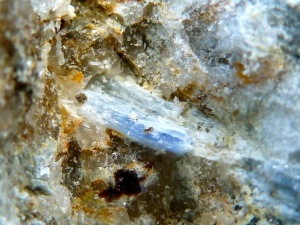 |
| More kyanite |
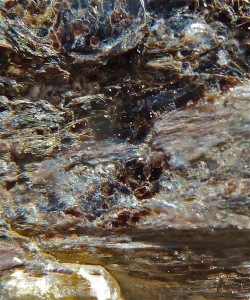 |
| Sillimanite (center) and biotite (top) |
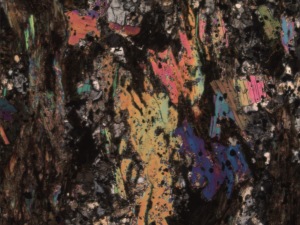 |
| Muscovite reacting at its rims to sillimanite at the 2nd sillimanite isograd (from the Little Cottonwood Stock aureole, Utah) |
![]() This work is licensed under a Creative Commons Attribution-NonCommercial-ShareAlike 4.0 International License.
This work is licensed under a Creative Commons Attribution-NonCommercial-ShareAlike 4.0 International License.
